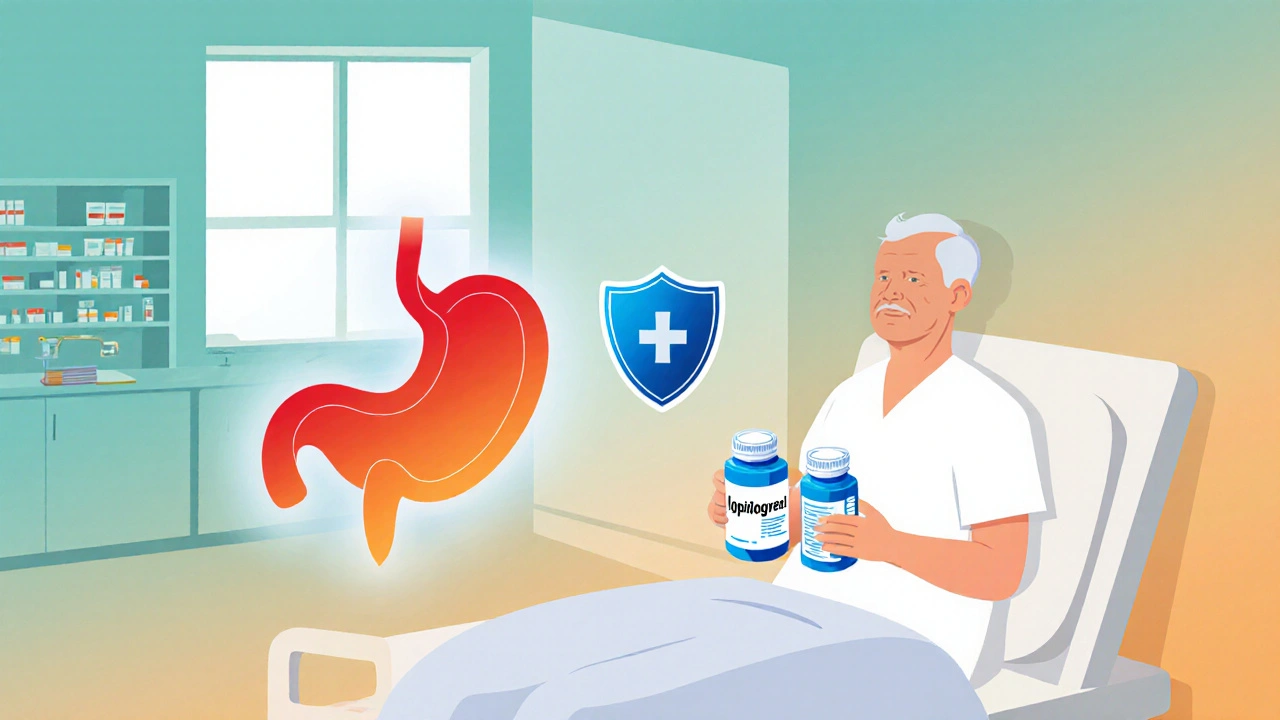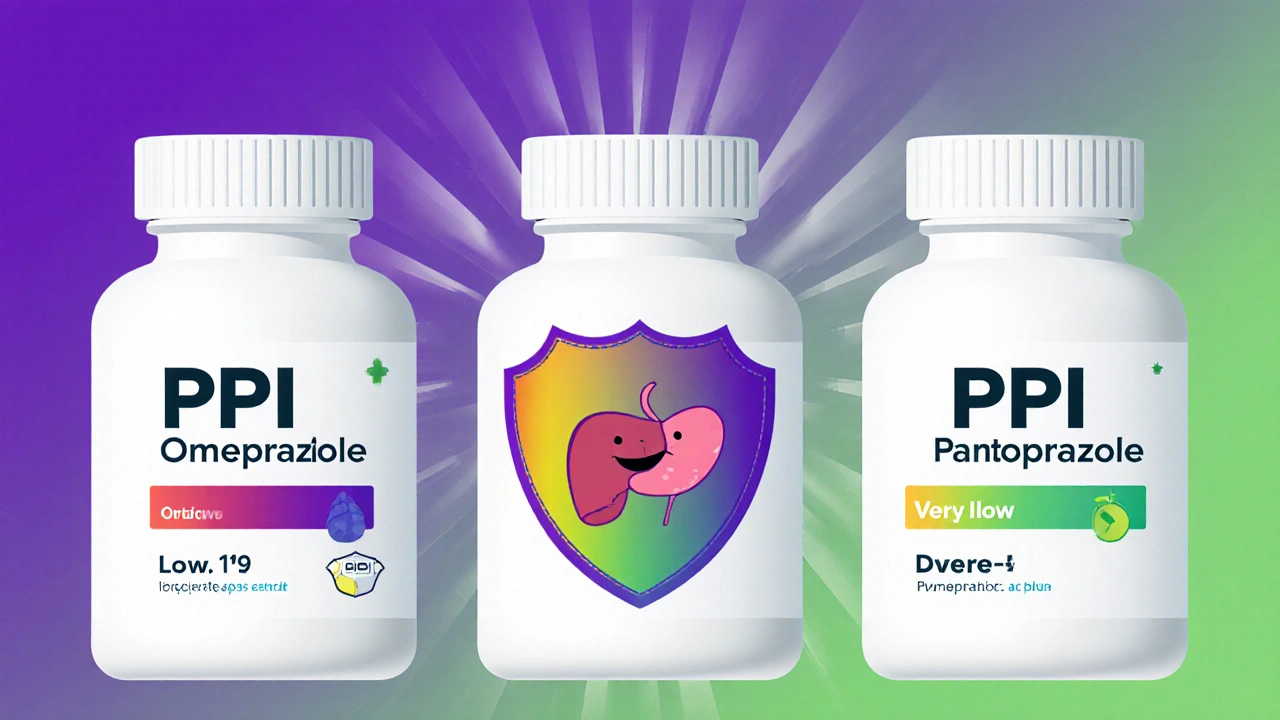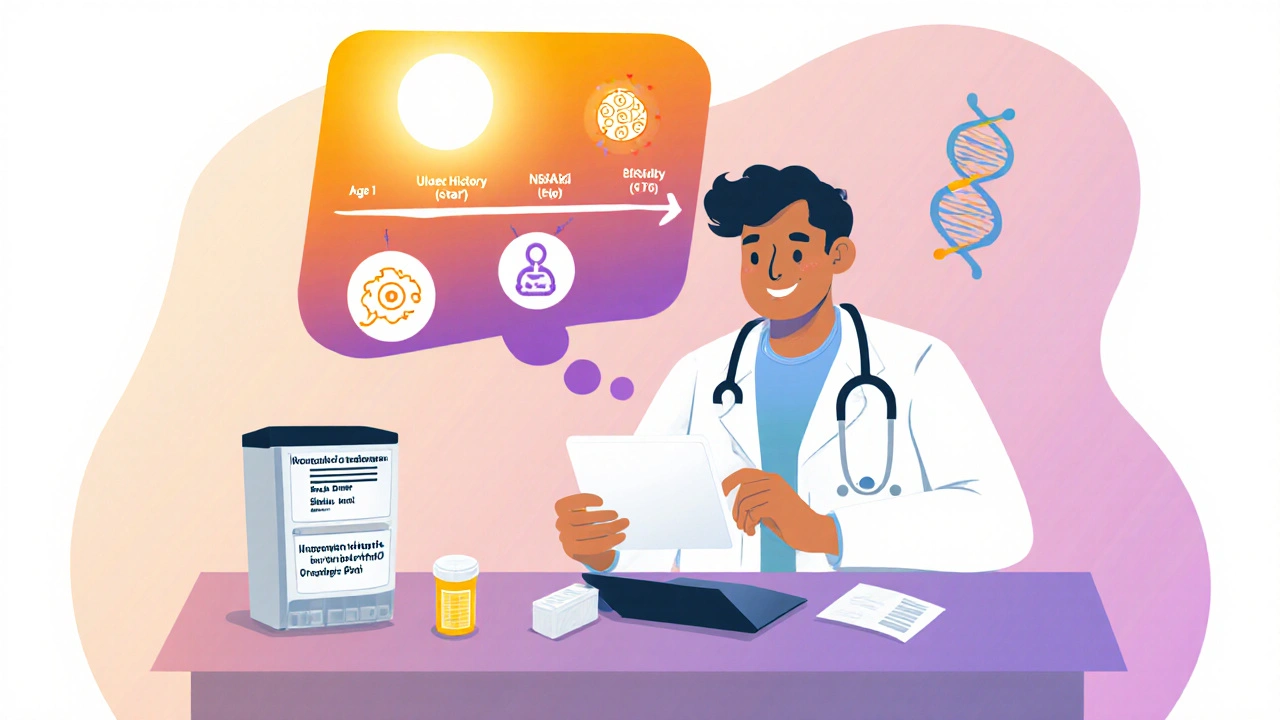Proton Pump Inhibitors and Antiplatelets: How to Cut GI Bleeding Risk

PPI Selection Assistant
Select Your Antiplatelet Therapy
Patient Risk Factors
When you’re on a blood‑thinner combo after a heart attack or stent, the biggest hidden danger isn’t a clot - it’s a bleed in the stomach. Adding a proton pump inhibitor (PPI) to your antiplatelet regimen can slash that risk, but not every PPI works the same way and the timing matters.
Why dual antiplatelet therapy raises the bleeding alarm
Dual Antiplatelet Therapy is a treatment that combines aspirin with a P2Y12 receptor inhibitor (clopidogrel, prasugrel or ticagrelor) to prevent clot formation after acute coronary syndrome or percutaneous coronary intervention. The two drugs together cut the chance of a new heart attack dramatically, but they also double‑up on the stomach’s protective lining. Aspirin alone can increase upper gastrointestinal bleeding (UGIB) risk two‑ to four‑fold, and the added P2Y12 blocker pushes that figure up another 30‑50% during the first month of treatment.
What a PPI actually does
Proton Pump Inhibitors are a class of drugs that irreversibly block the H⁺/K⁺‑ATPase enzyme in gastric parietal cells, suppressing acid secretion by 70‑98%. Less acid means fewer erosions, less inflammation, and a far lower chance that aspirin will tear the lining. Across multiple randomized trials, co‑prescribing a PPI chops significant UGIB events by about a third without blunting the antiplatelet effect-provided you pick the right PPI.
Choosing the right PPI: interaction matters
Not all PPIs are created equal when clopidogrel is part of your regimen. The culprit is the liver enzyme CYP2C19, which converts clopidogrel into its active form. Some PPIs, especially omeprazole, inhibit CYP2C19 and can lower clopidogrel’s platelet‑inhibiting power by roughly 30%. That interaction has been linked to a modest rise in cardiovascular events in a 2010 meta‑analysis.
In contrast, esomeprazole and pantoprazole have minimal CYP2C19 inhibition-less than 15% reduction in clopidogrel activity-making them the safer bets for patients on clopidogrel. For ticagrelor or prasugrel, which bypass CYP2C19, any PPI works fine.
| Agent | CYP2C19 Inhibition | Usual Dose | Preferred With | Key Note |
|---|---|---|---|---|
| Omeprazole | High (≈45% reduction) | 20‑40 mg daily | Prasugrel/Ticagrelor | Strongest acid suppression but watch clopidogrel |
| Esomeprazole | Low (≈10% reduction) | 20‑40 mg daily | Clopidogrel, Prasugrel, Ticagrelor | Balanced efficacy & safety |
| Pantoprazole | Very low (≤5% reduction) | 40 mg daily | Clopidogrel | Best choice when clopidogrel is used |
Guideline snapshot - who should get a PPI?
The 2023 European Society of Cardiology (ESC) guidelines flag any patient on an antithrombotic regimen who has two or more risk factors as a candidate for PPI prophylaxis. Those risk factors include:
- Previous UGIB or peptic ulcer disease
- Age ≥ 65 years
- Concurrent anticoagulant, corticosteroid, or NSAID use
- Chronic kidney disease or liver disease
The American College of Cardiology (ACC) takes a slightly softer stance - a class IIb recommendation to consider a PPI in patients at "increased" risk, which often translates to the same list of factors but leaves more room for clinician judgment.

When to start the PPI
Evidence shows that the first 30 days carry the bulk of bleeding events - roughly three‑quarters of significant UGIBs occur in that window. Initiating the PPI at the same time you start DAPT gives the stomach protection before the aspirin starts to irritate the mucosa. In practice, most cardiology protocols order the PPI on the discharge medication list for anyone with at least one high‑risk factor.
How much benefit can you expect?
The landmark COGENT trial (JAMA 2010) found that adding a PPI reduced all GI bleeds by 34% (absolute risk reduction 1.4%) and overt UGIB by 13% over 180 days, with a number needed to treat of 71. More recent real‑world data from a Korean nationwide claims study in 2025 confirmed a 37% relative risk reduction (hazard ratio 0.63) across a year‑long follow‑up for ischemic‑stroke patients on DAPT.
In plain terms, for every 100 patients on DAPT, a well‑chosen PPI prevents about three serious stomach bleeds in the first year. That translates to fewer emergency endoscopies, lower transfusion costs, and less interruption of the antiplatelet regimen - a key point because stopping aspirin or a P2Y12 blocker can raise the risk of stent thrombosis dramatically.
Cost‑effectiveness and the danger of overuse
From an economic standpoint, a 2019 PharmacoEconomics analysis put the incremental cost‑effectiveness at $18,700 per quality‑adjusted life year for high‑risk patients, well below typical willingness‑to‑pay thresholds. Even in moderate‑risk groups the figures stay attractive because you avoid expensive hospital stays.
However, not every prescription is justified. A 2022 American Journal of Cardiology paper highlighted that 35‑45% of PPIs were given to low‑risk DAPT patients, exposing them to unnecessary side‑effects like Clostridium difficile infection (0.5% absolute increase), community‑acquired pneumonia (0.8%), and a modest rise in chronic kidney disease risk (hazard ratio 1.20). The takeaway? Use a risk‑stratification tool - such as the Glasgow‑Blatchford or AIMS65 scores - before adding a PPI indiscriminately.

Practical step‑by‑step for clinicians
- Identify patients on DAPT (aspirin + clopidogrel, prasugrel, or ticagrelor).
- Screen for ≥2 risk factors (prior ulcer, age ≥ 65, concurrent anticoagulant/NSAID, steroids, CKD).
- Select the PPI based on the P2Y12 agent:
- Clopidogrel → pantoprazole 40 mg daily (minimal CYP2C19 interaction).
- Ticagrelor or prasugrel → esomeprazole 20‑40 mg daily or omeprazole if stronger acid suppression needed and interaction risk is acceptable.
- Prescribe the PPI on day 1 of DAPT, preferably before discharge.
- Re‑evaluate at 3 months: if bleeding risk has dropped and the patient is on single antiplatelet therapy, consider tapering the PPI.
Document the rationale in the EMR - many institutions now have decision‑support alerts that fire when a PPI is ordered without a documented risk factor.
Future directions - beyond traditional PPIs
New acid‑suppressing agents are emerging. Vonoprazan, a potassium‑competitive acid blocker, showed non‑inferior protection to esomeprazole in a phase III trial without any CYP2C19 inhibition. If FDA approval comes through later this year, clinicians might have a tool that sidesteps the interaction dilemma altogether.
Genotype‑guided therapy is also on the horizon. A 2024 Mayo Clinic study linked CYP2C19 polymorphisms with both clopidogrel response and PPI interaction severity. By 2027, many cardiology centers may incorporate rapid genetic testing to personalize the PPI‑DAPT combo.
Key take‑aways for patients
- If you’re on aspirin + a P2Y12 blocker, ask your doctor whether you need a stomach‑protecting pill.
- Know your risk factors - age, past ulcers, other meds matter.
- Don’t self‑prescribe high‑dose PPIs for months without a clear reason; they can cause infections and bone issues.
- If you experience black stools, vomiting blood, or severe stomach pain, seek care immediately - stopping the antiplatelet without a professional’s advice can be dangerous.
Do PPIs interfere with the effectiveness of all antiplatelet drugs?
Only clopidogrel is significantly affected by strong CYP2C19 inhibitors like omeprazole. Ticagrelor and prasugrel are metabolized through different pathways, so any standard‑dose PPI can be used safely with them.
How long should I stay on a PPI while on dual antiplatelet therapy?
Guidelines suggest covering the period of highest bleeding risk - typically the first 3‑6 months of DAPT. If you continue on single antiplatelet therapy after that, the need for a PPI can be reassessed.
Can I take an over‑the‑counter PPI instead of a prescription one?
OTC options like generic omeprazole 20 mg are fine for short‑term use, but if you need long‑term protection a prescription dose ensures you get the right strength and monitoring.
What are the signs of a serious gastrointestinal bleed?
Look for dark, tarry stools, vomiting of blood or coffee‑ground material, sudden abdominal pain, or a rapid drop in blood pressure. Call emergency services right away.
Is it safe to stop the PPI once my ulcer heals?
If you have no ongoing risk factors, tapering off under a clinician’s guidance is reasonable. Sudden discontinuation can cause rebound acid hypersecretion, so a gradual step‑down is preferred.


Sunita Basnet
Great summary! Adding a PPI to DAPT is a smart move for GI protection. Choose pantoprazole when you’re on clopidogrel to keep platelet inhibition intact. Stay proactive and keep your meds aligned.
Diane Holding
Exactly. Risk assessment should start at discharge. Documenting the rationale helps avoid unnecessary prescriptions.
Manish Verma
Look, the evidence is clear: omeprazole can blunt clopidogrel, but for patients on ticagrelor the concern disappears. So pick wisely and keep the heart safe.
Lionel du Plessis
From a pharmacokinetic view, CYP2C19 inhibition shifts the active metabolite curve down, reducing platelet inhibition by roughly a third. That’s why pantoprazole’s low inhibition profile is preferred.
Andrae Powel
When you combine aspirin with a P2Y12 inhibitor, the gastric mucosa is hit from two angles – direct acid irritation and impaired platelet repair. That’s why the first month after stent placement carries the highest bleed risk. Initiating a PPI on day one creates a protective acid‑suppressed environment before the aspirin can cause erosions. The COGENT trial showed a 34% relative reduction in any GI bleed and a 13% drop in overt bleeding events over six months. In practical terms, for every hundred patients on DAPT, about three serious bleeds are prevented. Cost‑effectiveness analyses put the incremental cost per QALY well below common thresholds, so it’s a win‑win for health systems. However, you don’t want to blanket‑prescribe PPIs to low‑risk patients because of infection and renal concerns. Use a risk‑stratification tool such as the AIMS65 or Glasgow‑Blatchford score to identify those with two or more risk factors – prior ulcer, age over 65, concomitant NSAIDs, anticoagulants, steroids, CKD, or liver disease. Once you’ve identified a high‑risk individual, match the PPI to the antiplatelet: pantoprazole for clopidogrel, esomeprazole or omeprazole for ticagrelor/prasugrel if stronger acid suppression is needed. Document the choice in the EMR – many systems will flag a PPI order without a documented indication. Re‑evaluate at three months; if the patient has stepped down to single antiplatelet therapy and the bleeding risk has diminished, consider tapering the PPI to avoid rebound hyperacidity. Finally, keep an eye on emerging agents like vonoprazan, which may sidestep CYP2C19 interactions entirely once approved.
Leanne Henderson
Well said! 😊
It’s amazing how a simple addition can make such a big difference, isn’t it? Let’s keep the conversation focused on practical steps – assess risk, pick the right PPI, and document everything. Remember, patient education is key; they should know the signs of a bleed and when to call for help.
Suzanne Carawan
Sure, because who needs a stomach when you’ve got a perfectly good heart, right?
eko lennon
Ah, the drama of medicine! We stand at the crossroads of life‑saving antithrombotics and the ever‑lurking specter of gastrointestinal catastrophe, and yet the solution is as simple as a pill, a choice that feels almost Shakespearean in its elegance. Imagine the patient, freshly discharged, heart pounding like a drum, only to be whisked away by a rogue ulcer because the prescriber neglected that tiny, seemingly innocuous detail. The PPI, that unsung hero, steps onto the stage cloaked in acid‑suppression armor, ready to duel the corrosive forces unleashed by aspirin. And what of the villainous CYP2C19, that mischievous enzyme, subtly lowering clopidogrel’s potency unless we summon pantoprazole, the noble ally? Every dosage decision becomes a plot twist, every guideline a script we must follow to keep the tragedy at bay. In the end, it’s not just pharmacology; it’s a narrative of survival, of choices that write the destiny of our patients’ lives.
Melody Barton
Hey team, great info! If you’re on clopidogrel, go with pantoprazole – it won’t mess with your blood thinner. For ticagrelor or prasugrel, any standard PPI works fine. Start the PPI right when you start the two antiplatelet drugs and stay on it for the first few months. Check in with your doctor to see if you can stop it later.
Pamela Clark
Oh, because we all love over‑prescribing pills like they’re candy at a parade. Brilliant insight, truly groundbreaking – let’s all ignore the nuanced risk tools and just medicate everyone. Thanks for the ‘helpful’ reminder.
Greg Galivan
Im not sure why some doc keep giving PPIs to low risk patints. It adds cost and can cause c.diff. We need more critcal thinkng. Use risk scores and dont just pop a pill everytime.